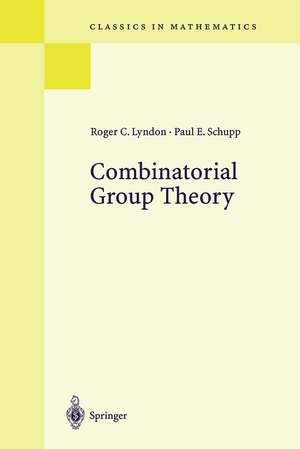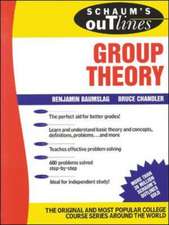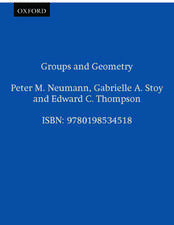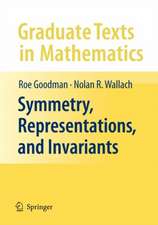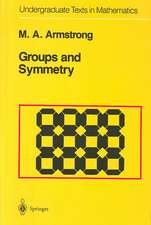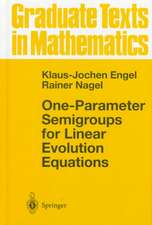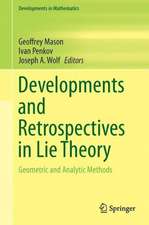Combinatorial Group Theory: Classics in Mathematics
Autor Roger C. Lyndon, Paul E. Schuppen Limba Engleză Paperback – 12 ian 2001
"This book (...) defines the boundaries of the subject now called combinatorial group theory. (...)it is a considerable achievement to have concentrated a survey of the subject into 339 pages. This includes a substantial and useful bibliography; (over 1100 (items)). ...the book is a valuable and welcome addition to the literature, containing many results not previously available in a book. It will undoubtedly become a standard reference." Mathematical Reviews, AMS, 1979
Din seria Classics in Mathematics
-
 Preț: 404.18 lei
Preț: 404.18 lei -
 Preț: 428.05 lei
Preț: 428.05 lei -
 Preț: 400.47 lei
Preț: 400.47 lei -
 Preț: 404.34 lei
Preț: 404.34 lei -
 Preț: 402.27 lei
Preț: 402.27 lei -
 Preț: 422.11 lei
Preț: 422.11 lei -
 Preț: 438.87 lei
Preț: 438.87 lei -
 Preț: 431.56 lei
Preț: 431.56 lei -
 Preț: 429.61 lei
Preț: 429.61 lei -
 Preț: 421.72 lei
Preț: 421.72 lei -
 Preț: 425.80 lei
Preț: 425.80 lei -
 Preț: 422.90 lei
Preț: 422.90 lei -
 Preț: 427.49 lei
Preț: 427.49 lei -
 Preț: 421.17 lei
Preț: 421.17 lei -
 Preț: 415.39 lei
Preț: 415.39 lei -
 Preț: 485.07 lei
Preț: 485.07 lei -
 Preț: 437.72 lei
Preț: 437.72 lei -
 Preț: 444.47 lei
Preț: 444.47 lei -
 Preț: 440.39 lei
Preț: 440.39 lei -
 Preț: 447.73 lei
Preț: 447.73 lei -
 Preț: 438.10 lei
Preț: 438.10 lei -
 Preț: 509.50 lei
Preț: 509.50 lei -
 Preț: 418.83 lei
Preț: 418.83 lei -
 Preț: 436.74 lei
Preț: 436.74 lei -
 Preț: 446.37 lei
Preț: 446.37 lei -
 Preț: 430.59 lei
Preț: 430.59 lei -
 Preț: 421.93 lei
Preț: 421.93 lei -
 Preț: 429.06 lei
Preț: 429.06 lei -
 Preț: 431.56 lei
Preț: 431.56 lei -
 Preț: 457.36 lei
Preț: 457.36 lei -
 Preț: 429.99 lei
Preț: 429.99 lei -
 Preț: 504.66 lei
Preț: 504.66 lei -
 Preț: 433.31 lei
Preț: 433.31 lei -
 Preț: 418.07 lei
Preț: 418.07 lei -
 Preț: 428.07 lei
Preț: 428.07 lei -
 Preț: 427.33 lei
Preț: 427.33 lei -
 Preț: 437.50 lei
Preț: 437.50 lei -
 Preț: 425.80 lei
Preț: 425.80 lei -
 Preț: 438.26 lei
Preț: 438.26 lei -
 Preț: 408.61 lei
Preț: 408.61 lei -
 Preț: 432.51 lei
Preț: 432.51 lei -
 Preț: 429.61 lei
Preț: 429.61 lei -
 Preț: 435.20 lei
Preț: 435.20 lei -
 Preț: 428.68 lei
Preț: 428.68 lei -
 Preț: 437.12 lei
Preț: 437.12 lei -
 Preț: 438.69 lei
Preț: 438.69 lei
Preț: 425.80 lei
Nou
Puncte Express: 639
Preț estimativ în valută:
81.48€ • 84.59$ • 67.95£
81.48€ • 84.59$ • 67.95£
Carte tipărită la comandă
Livrare economică 22 martie-05 aprilie
Preluare comenzi: 021 569.72.76
Specificații
ISBN-13: 9783540411581
ISBN-10: 3540411585
Pagini: 360
Ilustrații: XIV, 339 p.
Dimensiuni: 155 x 235 x 19 mm
Greutate: 0.52 kg
Ediția:Softcover reprint of the original 1st ed. 2001
Editura: Springer Berlin, Heidelberg
Colecția Springer
Seria Classics in Mathematics
Locul publicării:Berlin, Heidelberg, Germany
ISBN-10: 3540411585
Pagini: 360
Ilustrații: XIV, 339 p.
Dimensiuni: 155 x 235 x 19 mm
Greutate: 0.52 kg
Ediția:Softcover reprint of the original 1st ed. 2001
Editura: Springer Berlin, Heidelberg
Colecția Springer
Seria Classics in Mathematics
Locul publicării:Berlin, Heidelberg, Germany
Public țintă
ResearchCuprins
I. Free Groups and Their Subgroups.- 1. Introduction.- 2. Nielsen’s Method.- 3. Subgroups of Free Groups.- 4. Automorphisms of Free Groups.- 5. Stabilizers in Aut(F).- 6. Equations over Groups.- 7. Quadratic Sets of Word.- 8. Equations in Free Groups.- 9. Abstract Length Functions.- 10. Representations of Free Groups; the Fox Calculus.- 11. Free Products with Amalgamation.- II Generators and Relations.- 1. Introduction.- 2. Finite Presentations.- 3. Fox Calculus, Relation Matrices, Connections with Cohomology.- 4. The Reidemeister-Schreier Method.- 5. Groups with a Single Defining Relator.- 6. Magnus’ Treatment of One-Relator Groups.- III. Geometric Methods.- 1. Introduction.- 2. Complexes.- 3. Covering Maps.- 4. Cayley Complexes.- 5. Planar Caley Complexes.- 6. F-Groups Continued.- 7. Fuchsian Complexes.- 8. Planar Groups with Reflections.- 9. Singular Subcomplexes.- 10. Spherical Diagrams.- 11. Aspherical Groups.- 12. Coset Diagrams and Permutation Representations.- 13. Behr Graphs.-IV. Free Products and HNN Extensions.- 1. Free Products.- 2. Higman-Neumann-Neumann Extensions and Free Products with Amalgamation.- 3. Some Embedding Theorems.- 4. Some Decision Problems.- 5. One-Relator Groups.- 6. Bipolar Structures.- 7. The Higman Embedding Theorem.- 8. Algebraically Closed Groups.- V. Small Cancellation Theory.- 1. Diagrams.- 2. The Small Cancellation Hypotheses.- 3. The Basic Formulas.- 4. Dehn’s Algorithm and Greendlinger’s Lemma.- 5. The Conjugacy Problem.- 6. The Word Problem.- 7. The Conjugacy Problem.- 8. Applications to Knot Groups.- 9. The Theory over Free Products.- 10. Small Cancellation Products.- 11. Small Cancellation Theory over Free Products with Amalgamation and HNN Extensions.- Russian Names in Cyrillic.- Index of Names.
Recenzii
From the reviews:
"This book (...) defines the boundaries of the subject now called combinatorial group theory. (...)it is a considerable achievement to have concentrated a survey of the subject into 339 pages. This includes a substantial and useful bibliography; (over 1100 items). ...the book is a valuable and welcome addition to the literature, containing many results not previously available in a book. It will undoubtedly become a standard reference." Mathematical Reviews, AMS, 1979
"This is a reprint of the 1977 edition … of this famous and very popular book, which became a desk copy for everybody who is dealing with combinatorial group theory. The complete bibliography (more than 1000 titles) well reflects the situation in the combinatorial group theory at the time when the book was published. Definitely, since the face of combinatorial group theory has significantly changed … this well-written book still is very functional and efficient." (Igor Subbotin, Zentralblatt MATH, Vol. 997 (22), 2002)
"This book (...) defines the boundaries of the subject now called combinatorial group theory. (...)it is a considerable achievement to have concentrated a survey of the subject into 339 pages. This includes a substantial and useful bibliography; (over 1100 items). ...the book is a valuable and welcome addition to the literature, containing many results not previously available in a book. It will undoubtedly become a standard reference." Mathematical Reviews, AMS, 1979
"This is a reprint of the 1977 edition … of this famous and very popular book, which became a desk copy for everybody who is dealing with combinatorial group theory. The complete bibliography (more than 1000 titles) well reflects the situation in the combinatorial group theory at the time when the book was published. Definitely, since the face of combinatorial group theory has significantly changed … this well-written book still is very functional and efficient." (Igor Subbotin, Zentralblatt MATH, Vol. 997 (22), 2002)
Notă biografică
Biography of Roger C. Lyndon
Roger Lyndon, born on Dec. 18, 1917 in Calais (Maine, USA), entered Harvard University in 1935 with the aim of studying literature and becoming a writer. However, when he discovered that, for him, mathematics required less effort than literature, he switched and graduated from Harvard in 1939.
After completing his Master's Degree in 1941, he taught at Georgia Tech, then returned to Harvard in 1942 and there taught navigation to pilots while, supervised by S. MacLane, he studied for his Ph.D., awarded in 1946 for a thesis entitled The Cohomology Theory of Group Extensions.
Influenced by Tarski, Lyndon was later to work on model theory. Accepting a position at Princeton, Ralph Fox and Reidemeister's visit in 1948 were major influencea on him to work in combinatorial group theory. In 1953 Lyndon left Princeton for a chair at the University of Michigan where he then remained except for visiting professorships at Berkeley, London, Montpellier and Amiens.
Lyndon made numerous major contributions to combinatorial group theory. These included the development of "small cancellation theory", his introduction of "aspherical" presentations of groups and his work on length functions. He died on June 8, 1988.
Biography of Paul E. Schupp
Paul Schupp, born on March 12, 1937 in Cleveland, Ohio was a student of Roger Lyndon's at the Univ. of Michigan. Where he wrote a thesis on "Dehn's Algorithm and the Conjugacy Problem". After a year at the University of Wisconsin he moved to the University of Illinois where he remained. For several years he was also concurrently Visiting Professor at the University Paris VII and a member of the Laboratoire d'Informatique Théorique et Programmation (founded by M. P. Schutzenberger).
Schupp further developed the use of cancellation diagrams in combinatorial group theory, introducing conjugacy diagrams, diagrams on compact surfaces, diagrams over free products with amalgamation and HNN extensions and applications to Artin groups. He then worked with David Muller on connections between group theory and formal language theory and on the theory of finite automata on infinite inputs. His current interest is using geometric methods to investigate the computational complexity of algorithms in combinatorial group theory.
Roger Lyndon, born on Dec. 18, 1917 in Calais (Maine, USA), entered Harvard University in 1935 with the aim of studying literature and becoming a writer. However, when he discovered that, for him, mathematics required less effort than literature, he switched and graduated from Harvard in 1939.
After completing his Master's Degree in 1941, he taught at Georgia Tech, then returned to Harvard in 1942 and there taught navigation to pilots while, supervised by S. MacLane, he studied for his Ph.D., awarded in 1946 for a thesis entitled The Cohomology Theory of Group Extensions.
Influenced by Tarski, Lyndon was later to work on model theory. Accepting a position at Princeton, Ralph Fox and Reidemeister's visit in 1948 were major influencea on him to work in combinatorial group theory. In 1953 Lyndon left Princeton for a chair at the University of Michigan where he then remained except for visiting professorships at Berkeley, London, Montpellier and Amiens.
Lyndon made numerous major contributions to combinatorial group theory. These included the development of "small cancellation theory", his introduction of "aspherical" presentations of groups and his work on length functions. He died on June 8, 1988.
Biography of Paul E. Schupp
Paul Schupp, born on March 12, 1937 in Cleveland, Ohio was a student of Roger Lyndon's at the Univ. of Michigan. Where he wrote a thesis on "Dehn's Algorithm and the Conjugacy Problem". After a year at the University of Wisconsin he moved to the University of Illinois where he remained. For several years he was also concurrently Visiting Professor at the University Paris VII and a member of the Laboratoire d'Informatique Théorique et Programmation (founded by M. P. Schutzenberger).
Schupp further developed the use of cancellation diagrams in combinatorial group theory, introducing conjugacy diagrams, diagrams on compact surfaces, diagrams over free products with amalgamation and HNN extensions and applications to Artin groups. He then worked with David Muller on connections between group theory and formal language theory and on the theory of finite automata on infinite inputs. His current interest is using geometric methods to investigate the computational complexity of algorithms in combinatorial group theory.
Textul de pe ultima copertă
From the reviews:
"This book (...) defines the boundaries of the subject now called combinatorial group theory. (...)it is a considerable achievement to have concentrated a survey of the subject into 339 pages. This includes a substantial and useful bibliography; (over 1100 items). ...the book is a valuable and welcome addition to the literature, containing many results not previously available in a book. It will undoubtedly become a standard reference." Mathematical Reviews, AMS, 1979
"This book (...) defines the boundaries of the subject now called combinatorial group theory. (...)it is a considerable achievement to have concentrated a survey of the subject into 339 pages. This includes a substantial and useful bibliography; (over 1100 items). ...the book is a valuable and welcome addition to the literature, containing many results not previously available in a book. It will undoubtedly become a standard reference." Mathematical Reviews, AMS, 1979
Caracteristici
Lyndon and Schupp coauthored one of the most important works on combinatorial group theory: The book was eagerly awaited by those interested in research in this area, and people working at the time remember the excitement of seeing the book when it first appeared and was passed round a lecture theatre at a conference
